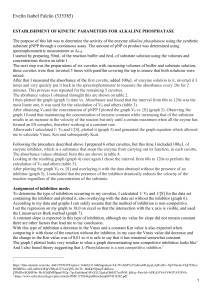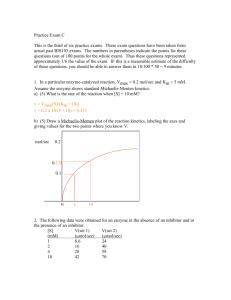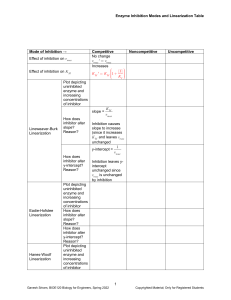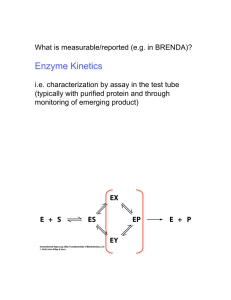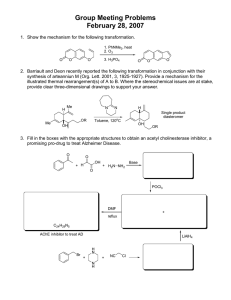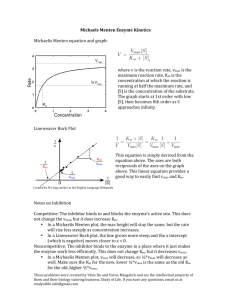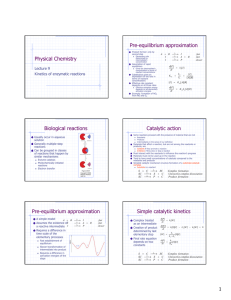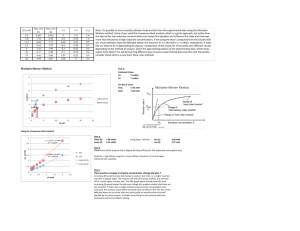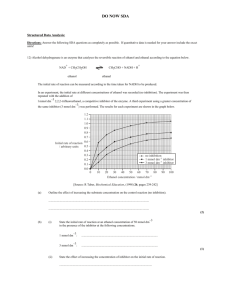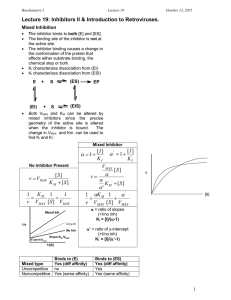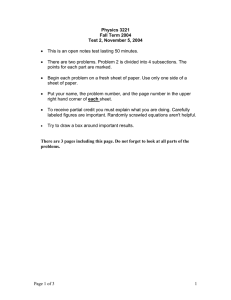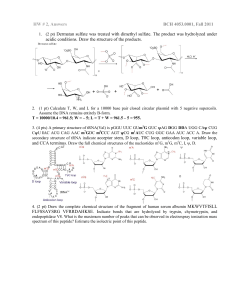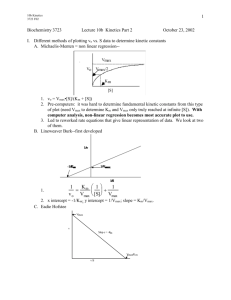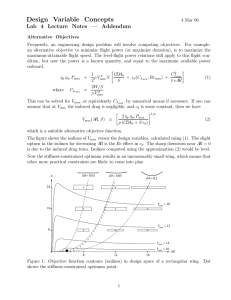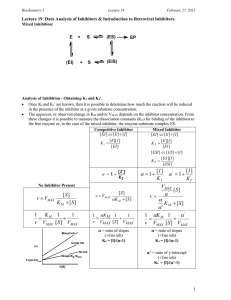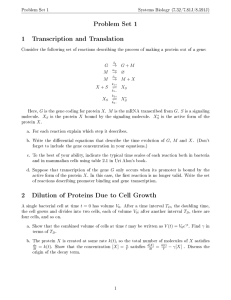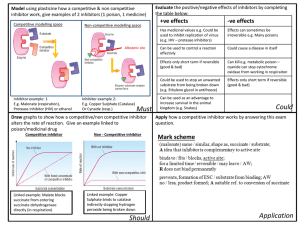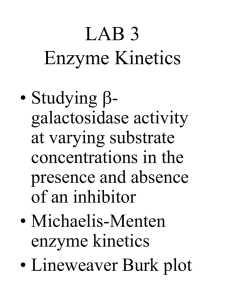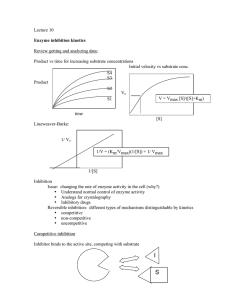ENZYME KINETICS PRACTICE PROBLEMS
advertisement
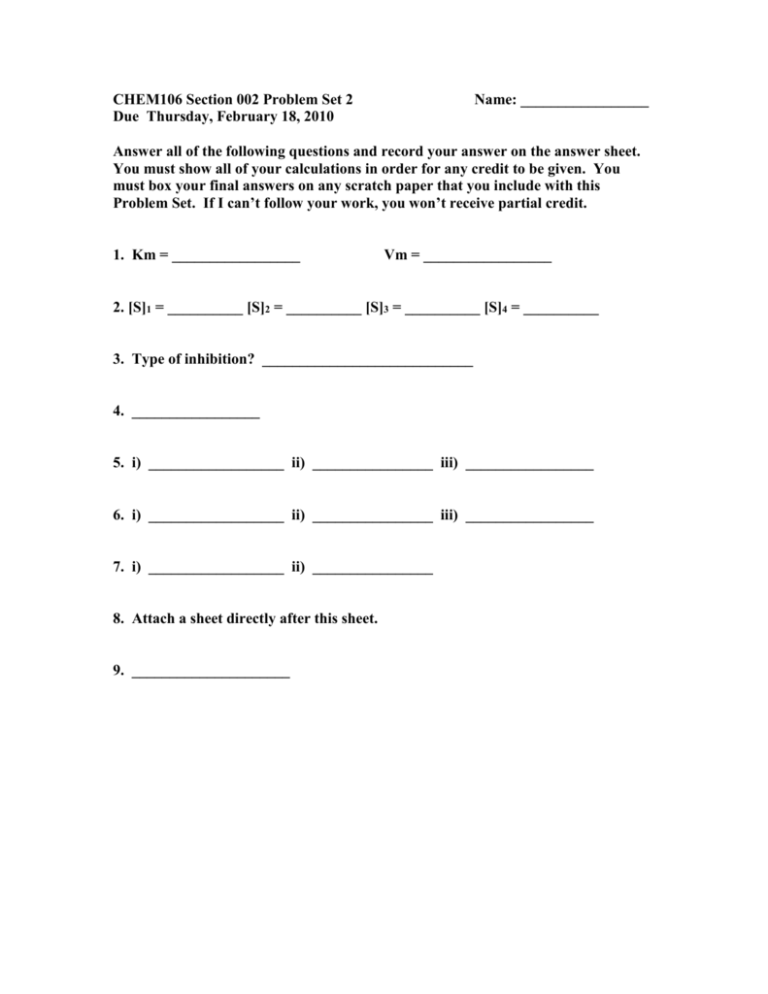
CHEM106 Section 002 Problem Set 2 Due Thursday, February 18, 2010 Name: _________________ Answer all of the following questions and record your answer on the answer sheet. You must show all of your calculations in order for any credit to be given. You must box your final answers on any scratch paper that you include with this Problem Set. If I can’t follow your work, you won’t receive partial credit. 1. Km = _________________ Vm = _________________ 2. [S]1 = __________ [S]2 = __________ [S]3 = __________ [S]4 = __________ 3. Type of inhibition? ____________________________ 4. _________________ 5. i) __________________ ii) ________________ iii) _________________ 6. i) __________________ ii) ________________ iii) _________________ 7. i) __________________ ii) ________________ 8. Attach a sheet directly after this sheet. 9. _____________________ 1. 2. 3. The following data were obtained from an enzyme kinetics experiment. Graph the data using a Lineweaver-Burk plot and determine, by inspection of the graph, the values for Km and Vmax. [S] (µM) _______ V (nmol/min) ___________ 0.20 0.26 0.33 1.00 1.43 1.67 2.08 3.33 Use the Michaelis-Menton Equation to calculate the missing values of [S] given below if Vmax = 5 mmol/min. Plot [S] versus V (NOT the reciprocals!). Draw line parallel to the x-axis at Vmax and extend your plotted line to show its approach to Vmax. [S] (mM) _______ V (mmol/min) ___________ 10 [S]1 [S]2 [S]3 [S]4 1.2 1.7 2.1 2.2 2.5 The effect of an inhibitor on an enzyme was tested and the experiment gave the results below. Plot the data and determine, by inspection of the graph, what type of inhibition is involved. [S] µM ______ 0.4 0.67 1.00 2.00 4. V (µmol/min) with 0.0 nM Inhibitor ___________ V (µmol/min) with 25 nM Inhibitor ___________ V (µmol/min) with 50 nM Inhibitor ___________ 0.22 0.29 0.32 0.40 0.21 0.26 0.30 0.36 0.20 0.24 0.28 0.32 How many ml of a 0.2 M NaOH solution are required to bring the pH of 20 ml of a 0.4 M HCl solution to 7.0? 5. The following questions refer to the figure. You must CALCULATE every answer, you cannot simply look at the titration curve and make an approximatation. i) ii) What is the pKa of the weak acid? What was the original concentration of the acid if the starting volume of acid was 18.60 mL? Calculate the pH at the equivalence point. iii) 6. The following questions refer to the figure. You must CALCULATE every answer, you cannot simply look at the titration curve and make an approximatation. i) ii) What is the pKb of the weak base? What was the original concentration of the base if the starting volume of base was 7.50 mL? Calculate the pH at the equivalence point. iii) 7. Answer the following questions. i) Draw a tripeptide having R groups consisting of methyl, hydroxyl, and phenol groups. ii) When a protein is dissolved in water, the amino acids found in its interior are likely to have R groups which are: a) hydrophilic b) charged c) highly reduced d) polar e) all of the above f) none of the above 8. Draw the structure of the following compounds: i) ii) iii) iv) v) 2,4-dimethyl-3-pentanol 1-ethyl-3-methylbenzene 2,6-diaminohexanoic acid 1-methoxy-3-hexanone benzaldehyde 9. You have 200 mg of aspirin (FW= 180g/mole) dissolved in 50 mL of water. You take 5 mL of this solution and bring it to 200 mL with water. You then take 100 mL of that and bring it to 1000 mL with water. You take 5 mL of that solution and add it to 10 mL of water. What is the molarity of aspirin in the final solution?
